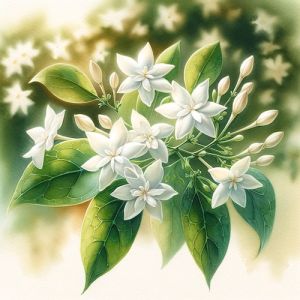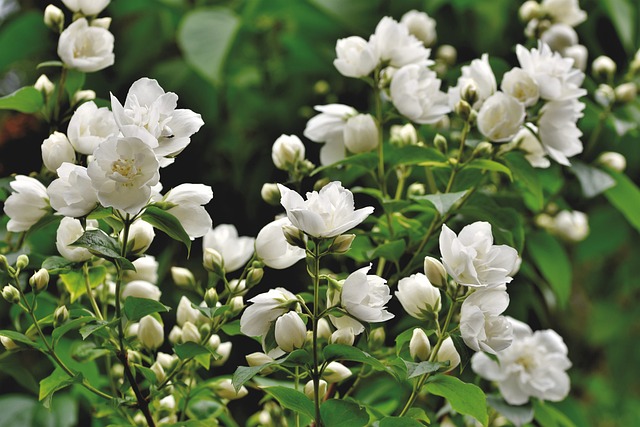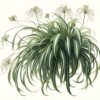Discover the World of Jasmine – From Planting to Perfume
Introduction
Embark on a journey through the world of Jasmine, a plant renowned for its mesmerizing fragrance and beautiful flowers. This guide is your gateway to understanding and appreciating the delicate beauty of Jasmine. Here, we’ll explore its rich history, varied species, and the essentials of Jasmine care, providing you with the knowledge to bring this fragrant wonder into your own garden.
Jasmine: A Fragrant Treasure
Botanical Overview
Discover the botanical essence of Jasmine, a plant that has charmed the senses for centuries. Its diverse species and captivating fragrance make it a favorite among plant enthusiasts.
- Common Name – Jasmine
- Scientific Name – Jasminum
- Family – Oleaceae
- Description – Jasmine spans over 200 species in the shrub and vine genus, celebrated for its aromatic flowers and diverse utility. The star-shaped flowers and rich fragrance have been a garden and perfumery staple throughout history.
The Medicinal and Cultural Significance of Jasmine
Jasmine, beyond its captivating aroma, plays a significant role both in traditional medicine and cultural practices. Medically, Jasmine is revered for its antiseptic, antidepressant, and antispasmodic properties. The essential oil, derived from its fragrant flowers, is a sought-after natural remedy, aiding in stress reduction and promoting a sense of relaxation and mental well-being. In addition, Jasmine tea, a delightful infusion of Jasmine flowers with green or white tea, is not just a sensory pleasure but also a health booster, known for its immune-enhancing and antioxidant properties. Topically, Jasmine’s soothing and anti-inflammatory effects have been utilized in treating various skin conditions.
Culturally, Jasmine holds a place of honor in many societies. In parts of Asia, it symbolizes purity, love, and moral beauty, often used in religious and wedding ceremonies. The flower’s role in these rituals transcends mere decoration, embodying spiritual and emotional significance. Arabian Jasmine (Jasminum sambac), in particular, is a national symbol in the Philippines, known as ‘sampaguita’, and in Indonesia, where it goes by ‘melati putih’. This cultural reverence underscores Jasmine’s deep-rooted presence in human history, intertwining its medicinal benefits with its symbolic importance across the world. As with any herbal remedy, consultation with a healthcare professional is recommended before using Jasmine for medicinal purposes.
Varieties of Jasmine
Jasmine’s diversity is as enchanting as its fragrance. Each variety offers unique attributes and beauty, making Jasmine a versatile choice for gardeners.
- Jasminum officinale (Common Jasmine) – Known for white, intensely fragrant flowers, popular in teas and perfumes.
- Jasminum sambac (Arabian Jasmine) – Features small, waxy flowers with a robust fragrance, used in religious rituals and perfume making.
- Jasminum polyanthum (Pink Jasmine) – Distinct for its pink buds and fragrant white flowers, perfect for decorating trellises.
- Jasminum mesnyi (Japanese Jasmine) – Showcases bright yellow flowers and shiny foliage, adding a vibrant touch to any garden.
Planting and Growth Conditions
Jasmine thrives under specific conditions. Understanding these will ensure your Jasmine grows healthily and blooms beautifully.
- Sunlight – Prefers full sun to partial shade.
- Soil – Ideal soil is well-draining and fertile, with a slightly acidic to neutral pH.
- Planting Tips – Optimal planting times are in spring or early fall, considering space for growth and airflow.
Care and Maintenance
Proper care and maintenance are key to nurturing healthy Jasmine plants. These tips will help you cultivate lush, fragrant Jasmine in your garden.
- Watering – Regular watering is essential, keeping the soil moist but not waterlogged.
- Fertilizing – Balanced fertilization during the growing season promotes healthy growth and flowering.
- Pruning – Regular pruning after flowering maintains the plant’s shape and health.
Benefits and Uses
Jasmine is more than a pretty face; its uses extend into various aspects of wellness and garden aesthetics.
- Aromatherapy – Jasmine oil, known for its relaxing properties, is a staple in aromatherapy.
- Tea – Jasmine-infused tea is celebrated for its delicate flavor and soothing qualities.
- Landscaping – Jasmine is perfect for creating scented ground covers, hedges, or climbers, enhancing the garden’s visual and aromatic appeal.
Potential Problems
Awareness of potential challenges will equip you to keep your Jasmine plants healthy and thriving.
- Pests – Vigilance against aphids, scale insects, and spider mites is crucial.
- Diseases – Jasmine may be prone to fungal diseases like powdery mildew, especially in humid climates.
Conclusion
Introducing Jasmine to your garden promises a world of fragrance and beauty. Its elegant blooms and soothing scent make it an attractive and rewarding choice for any gardener. Embrace the joy of gardening with Jasmine and let it enhance your garden and your well-being. Happy gardening!
Jasmine Plant FAQ
- What are the most common varieties of Jasmine? Common varieties include Jasminum officinale (Common Jasmine), Jasminum sambac (Arabian Jasmine), Jasminum polyanthum (Pink Jasmine), and Jasminum mesnyi (Japanese Jasmine).
- How much sunlight does Jasmine need? Jasmine generally thrives in full sun to partial shade, requiring at least 4-6 hours of sunlight daily.
- What soil type is best for Jasmine? Well-draining, fertile soil with a slightly acidic to neutral pH is ideal for Jasmine plants.
- When is the best time to plant Jasmine? The optimal time for planting Jasmine is during spring or early fall.
- How often should I water Jasmine? Water Jasmine to keep the soil consistently moist but not waterlogged, especially during the flowering season.
- What fertilizer should I use for Jasmine? A balanced fertilizer applied during the growing season is recommended. Avoid high nitrogen fertilizers to prevent excessive foliage at the expense of blooms.
- How do I prune Jasmine? Prune Jasmine after flowering to maintain its shape and remove dead or diseased branches.
- Can Jasmine be used for making tea? Yes, Jasmine flowers are often used to flavor green or white tea, creating Jasmine tea.
- What pests and diseases commonly affect Jasmine? Common issues include aphids, scale insects, spider mites, powdery mildew, and root rot.
- Can Jasmine be used in landscaping? Absolutely, Jasmine can be used as a fragrant ground cover, hedge, or climbing vine, adding beauty and scent to garden landscapes.












You must be logged in to post a comment.